The Tibetan Karma Kagyu Temple is a buddhist temple and tourist attraction
located in Bodh Gaya, Bihar, India.
Karma Kagyu is a widely practiced and probably the second-largest lineage
within the Kagyu school, one of the four major schools of Tibetan Buddhism.
The Kagyu lineage claims a continuity of oral instructions transmitted from
master to disciple. The elders in the Kagyu lineage, representing the
theoretically uninterrupted line of masters and disciples reaching back to
Buddha (Vajradhara), are jointly known as the "Golden Rosary."
The Karma Kagyu school belongs to the Vajrayana branch of Mahayana Buddhism.
It conceives itself as a member of the third turning of the dharmacakra and
participates in the Rimé movement. Important teachings of the Kagyu school
include the Buddhist philosophical traditions of Yogacara and Madhyamaka, as
well as the tantric tradition of Chakrasamvara, among others.
|
Virudhaka (left) and Dhritarastra (right).
The Four Heavenly Kings are four Buddhist gods or devas, each of whom is
believed to watch over one cardinal direction of the world.
-
Virudhaka is the guardian of the southern direction. He lives
on the southern part of Mount Sumeru. In iconographic form, he is clad
in armor while brandishing a sword.
-
Dhrtarastra is the guardian of the eastern direction. He lives
on the eastern part of Mount Sumeru. Dhrtarastra is considered to be a
god of music. In iconography, he holds a lute (pipa) in his
hands, indicating his desire to use music to convert sentient beings
to Buddhism.
-
See more at
Virūḍhaka - Wikipedia
and
Dhṛtarāṣṭra - Wikipedia.
|
|
Virupaksa (left) and Vaisravana (right).
The Four Heavenly Kings are said to currently live in the Four Great
Kings Heaven (Caturmaharajika) on the lower slopes of Mount
Sumeru, which is the lowest of the six worlds of the devas of the
Kamadhatu. They are the protectors of the world and fighters of evil,
each able to command a legion of supernatural creatures to protect the
Dharma.
-
Virupaksa is the guardian of the western direction. He lives on
the western part of Mount Sumeru. He possesses the divine eye, which
allows him to see great distances as well as the karma of sentient
beings. He is commonly depicted as having red skin and clad in armor.
He is often depicted as gripping a red naga or a red lasso in his
hands, which he uses to snare people into the Buddhist faith.
-
Vaisravana is the guardian of the northern direction, and his
home is in the northern quadrant of the topmost tier of the lower half
of Mount Sumeru. He is often portrayed with a yellow face. He carries
an umbrella or parasol (chatra) as a symbol of his sovereignty. He is
also sometimes displayed with a mongoose, often shown ejecting jewels
from its mouth. The mongoose is the enemy of the snake, a symbol of
greed or hatred; the ejection of jewels represents generosity.
-
See more at
Virūpākṣa - Wikipedia
and
Vaiśravaṇa - Wikipedia.
|
See also
Sources
Location
Mahabodhi Temple by Night
Tara Temple Inauguration
Mahabodhi Temple
Chinese Temple
Wat Thai Temple
Great Buddha
Tara Temple 3D Mandalas
Tara Temple Morning Prayer





